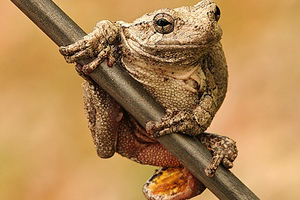Skin secretions of these frogs are noxious to certain potential predators and may cause irritation if they contact human eyes or other sensitive membranes.
Photo Credit: Mike Keeling
Dryophytes chrysoscelis
Common Name: Cope's gray treefrog
Other Scientific Names: Hyla chrysoscelis
Animal Guild: Amphibian
Class > Order > Family: Amphibia > Anura > Hylidae
What does the species look like?
This species is visually identical to the more northern gray treefrog (Dryophytes versicolor) The back has numerous small warts and is usually green (especially juveniles) to gray and often bears a pattern that resembles lichens that grow on tree trunks. There is a light spot under each eye. The groin and concealed bases of the hind legs are orange-yellow with black mottling. Maximum size is about 2.5 inches (6 cm) snout-vent length. Breeding male can be recognized by its dark loose throat skin. Breeding calls are loud trills (often mistaken for a woodpecker's call), with pulses emitted faster than in the gray treefrog (Dryophytes versicolor). Larvae have strongly arched tails fins that may be heavily mottled with black and often tinged red or orange, and (if not broken) ending in a slender filament. Larvae reach a total length of up to 1.5 inches (3.8 cm). Egg masses contain clusters of about 6-45 eggs, floating free or loosely attached to submerged vegetation.
Where is the species found?
States & Provinces
AL, AR, DC, DE, FL, GA, IA, IL, IN, KS, KY, LA, MB, MD, MI, MN, MO, MS, NC, ND, NE, NJ, OH, OK, SC, SD, TN, TX, VA, WI, WV
Distribution
In some regions the distribution of this frog is not precisely known due to confusion with the very similar gray treefrog. The known range includes most of the south-central and southeastern United States and areas west of the Great Lakes, from Manitoba, Minnesota, Wisconsin, Michigan, southern Ohio, West Virginia, and Maryland south to eastern Texas, the Gulf Coast, and northern Florida.
Cope's gray treefrogs inhabit wooded areas and woodland edges (including woodlots in prairies), usually within a few hundred meters of the aquatic habitats in which they breed. Often they occur in recently disturbed areas with abundant shrubs, herbaceous growth, and vines. Activity is arboreal and terrestrial. Breeding sites include temporary or permanent waters of flooded ditches, puddles, river sloughs, creeks, and small ponds, where there are woody branches or extensive herbaceous growth along the edges. Males call from the water surface or from vegetation or ground near water.
General Phenology and Life History
These frogs are inactive during cold winter months, especially in the north. Most activity occurs at dusk and at night in summer. When inactive, frogs may hide in tree holes, or beneath bark, leaves, or tree roots. Breeding occurs in spring-early summer (May-early July in Kansas, April-July in Maryland, April-August in western Tennessee). Often, but not always, breeding is stimulated by rainfall and warm temperatures. A female's clutch is divided among small clusters of around 20-40 eggs that are deposited at the water's surface or attached to emergent plants. Eggs hatch in several days. Larvae metamorphose in about 6-9 weeks, by the end of summer (may rarely overwinter).
Which phenophases should I observe?
Do you see/hear...?
Activity
Adults on land More...
For abundance, enter the number of individual animals observed in this phenophase.
Adults in water More...
For abundance, enter the number of individual animals observed in this phenophase.
Adults feeding For abundance, enter the number of individual animals observed in this phenophase.
Reproduction
Vocalizing What is the intensity of vocalizing?
Single calls: There is space between calls and individuals can be counted. Overlapping calls: Calls of individuals can be distinguished but there is some overlapping of calls. Full chorus: Calls are constant and overlapping.
Mating For abundance, enter the number of individual animals observed in this phenophase.
Fresh eggs For abundance, enter the number of individual animals observed in this phenophase.
Development
Dead adults For abundance, enter the number of individual animals observed in this phenophase.
What do these phenophases look like?
There is currently no photoguide available for this species. If you'd like help us create one, use the guidance document and species template provided here . Then send it via email to education@usanpn.org when it is complete.
